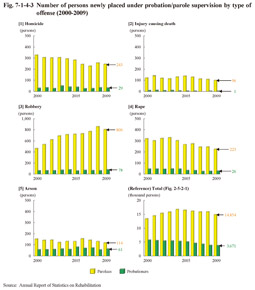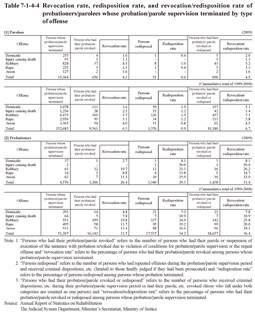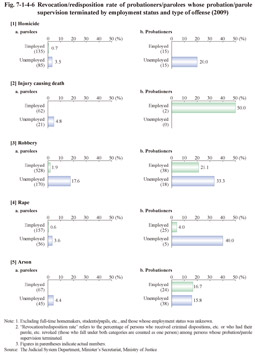2 Probation/parole supervision
(1) Number of persons newly placed under probation/parole supervision
Fig. 7-1-4-3 shows the number of probationers/parolees for serious offenses newly placed under probation/parole supervision over the last 10 years. The number of parolees newly placed under parole supervision for robbery has been on an increasing trend while that for homicide, injury causing death, rape, and arson on a decreasing trend in recent years. The number of probationers newly placed under probation for homicide, robbery, and arson has remained stable while that for rape has been on a decreasing trend, while that for injury causing death has been either one or zero in recent years.
Fig. 7-1-4-3 Number of persons newly placed under probation/parole supervision by type of offense (2000-2009)
(2) Status of redisposition, etc.
Table 7-1-4-4 shows the revocation rate, redisposition rate, and revocation/redisposition rate (See Subsection 2, Section 4, Chapter 6, Part 3 for the meaning of revocation rate, etc.) of probationers/parolees for serious offenses whose probation/parole supervision terminated in 2009 and of those terminated in 1999-2008 (cumulative total).
Table 7-1-4-4 Revocation rate, redisposition rate, and revocation/redisposition rate of probationers/parolees whose probation/parole supervision terminated by type of offense
The revocation rate and revocation/redisposition rate of parolees for robbery have been at the same level as those of all parolees while those for homicide, injury causing death, rape, and arson have been lower than those of all parolees. The revocation rate, redisposition rate, and revocation/disposition rate of those whose parole supervision terminated in 2009 was remarkably lower than that of those whose parole supervision terminated in 1999-2008 for all parolees and for parolees for serious offenses. The revocation/redisposition rate of parolees for homicide, injury causing death, rape, and arson whose parole supervision terminated in 2009 was low at 1.1-2.0%.
The revocation rate, redisposition rate, and revocation/redisposition rate of probationers were remarkably lower for every serious offense than those of all probationers. For rape and arson the revocation rate, redisposition rate, and revocation/redisposition rate of those whose probation terminated in 2009 was lower than those whose probation terminated in 1999-2009. For injury causing death the redisposition rate and revocation/redisposition rate of those whose probation terminated in 2009 were both 50% (only two persons had their probation terminated and one of them was redisposed).
Of probationers/parolees for serious offenses having their probation/parole supervision terminated in the period between 2000 and 2009 who received criminal dispositions, etc. due to repeat offenses (limited to those finally judged in case of having been prosecuted) during the probation/parole supervision period or those who had their probation/parole supervision revoked for a violation of the conditions for their supervision or for repeat offenses during their probation/parole supervision period, Table 7-1-4-5 shows the period between the starting date of their probation/parole supervision and the date of the pertinent criminal disposition, etc. or revocation.
Table 7-1-4-5 Period between the starting date of probation/parole supervision and the date of redisposition or revocation by type of offense (cumulative total of 2000-2009)
Fig. 7-1-4-6 shows the revocation/redisposition rate of probationers/parolees for serious offenses whose probation/parole supervision terminated in 2009 by employment status at the time of termination of their probation/parole supervision. The revocation/redisposition rate of those unemployed was remarkably higher than that of those who were employed. There was no difference, however, in the revocation/redisposition rate of probationers for arson between those employed and those unemployed. There were only two probationers for injury causing death, both of whom were employed.
Fig. 7-1-4-6 Revocation/redisposition rate of probationers/parolees whose probation/parole supervision terminated by employment status and type of offense (2009)



